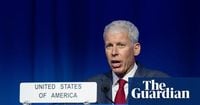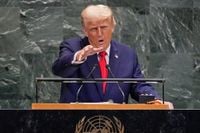On September 23, 2025, President Donald Trump took center stage at the United Nations General Assembly in New York, making it abundantly clear that his administration would not just step back from the global fight against climate change, but actively work to undermine it. His remarks—sharp, unabashed, and controversial—sent ripples through the hall packed with world leaders and reverberated across the international climate community.
"I’m telling you that if you don’t get away from the green energy scam, your country is going to fail," Trump declared, according to POLITICO, leveling his criticism at nations embracing renewable energy policies. He doubled down on the benefits of U.S.-produced fossil fuels, openly ridiculing efforts to transition to wind, solar, and other green energy sources. For Trump, the message was plain: fossil fuels are the future, and green policies are a costly detour.
This speech landed at a critical juncture. The following day, world leaders were set to unveil new 10-year pledges to cut emissions, and in November, global climate negotiations would unfold in Brazil. Yet, as POLITICO notes, expectations for meaningful progress were already low, hampered by a lack of U.S. leadership and a host of other international challenges. Trump’s rhetoric only deepened the sense of uncertainty.
Back in Washington, the Trump administration was preparing to take an even bolder step: rescinding the Environmental Protection Agency’s (EPA) Endangerment Finding. This 2009 determination, as reported by the Council on Foreign Relations (CFR), had long served as the legal backbone for regulating six heat-trapping greenhouse gases under the Clean Air Act. Its reversal would upend the government’s ability to curb emissions from vehicles, power plants, and industry, marking what EPA Administrator Lee Zeldin called "the largest deregulatory action in the history of America." Zeldin predicted it would "drive a dagger straight into the heart of the climate change religion."
For sixteen years, the Endangerment Finding had guided U.S. climate policy. But as CFR’s Alice C. Hill pointed out, the Trump administration’s move would strip the EPA of its obligation to regulate greenhouse gases, potentially accelerating the rollback of existing climate regulations. Critics, including Hill and fellow CFR experts Varun Sivaram and David M. Hart, argue that this approach ignores peer-reviewed science and regulatory history, putting lives and livelihoods at risk while diminishing America’s role in fighting climate change.
"The EPA’s Endangerment Finding fails this test, so I’m happy to bid it good riddance," Sivaram wrote, yet he acknowledged the underlying science: "Six greenhouse gases taken in combination endanger both the public health and the public welfare of current and future generations." Still, Sivaram questioned whether the regulatory path enabled by the Endangerment Finding was the most effective means to address the problem, especially given that U.S. vehicle emissions cuts would reduce global greenhouse gases by less than 1 percent this decade.
Hart, in turn, emphasized the global nature of the challenge. "The United States cannot control global greenhouse gas emissions by itself," he noted. "Even if the U.S. eliminated its emissions today, that might have little effect on the pace of climate change." But he warned that handcuffing the federal government, as Trump’s EPA proposed, could remove the possibility for future administrations to join international efforts to limit emissions.
Trump’s campaign against climate regulation did not stop at the EPA. According to CFR, his administration reportedly requested NASA to end two satellite missions that monitor atmospheric carbon dioxide and proposed cutting funding for the Mauna Loa Observatory in Hawaii, which boasts the world’s longest continuous record of atmospheric carbon. Additionally, the administration terminated a key database tracking climate-related disasters costing over $1 billion since 1980, and dismissed hundreds of scientists from the nation’s sixth national climate assessment, a Congressionally mandated report grounded in peer-reviewed science.
Hill warned that these moves would leave American communities and businesses "flying blind" to the risks of climate change. "Without access to up-to-date authoritative climate information, American communities and businesses will fly blind to the risks from climate change that their government apparently no longer wants to protect them from," she wrote.
On the international stage, Trump’s message was both defiant and dismissive. He urged European leaders to abandon wind projects in favor of more oil and gas drilling in the North Sea, a suggestion he said he had repeated to U.K. Prime Minister Keir Starmer. Yet, U.K. Energy Secretary Ed Miliband remained steadfast, telling POLITICO that clean energy was "the route to energy security and good jobs and climate action." Miliband insisted, "I’m confident that what we’re doing is not only in the interest of the British people but is what the British people elected us to do."
United Nations Secretary-General António Guterres responded before Trump’s speech, asserting, "No government, industry or special interest can stop" the clean energy transition, even as he acknowledged that "some are trying." The clean energy shift, Guterres and other leaders argued, is already delivering jobs and reducing dependence on volatile fossil fuel imports.
Trump’s remarks didn’t resonate with all. A diplomat from a developing country told POLITICO, "We don’t have time for denialism. We’re dealing with realities on the ground." Meanwhile, nearly 20 world leaders signed a letter calling for a "just and equitable" clean energy transition, and Brazil announced the creation of the Tropical Forests Forever Fund, pledging $1 billion to global forest preservation.
At home, Trump’s administration cleared regulations for oil and gas, blocked several major offshore wind projects, slashed federal research, and deleted climate data. He argued that "immigration and the high cost of so-called green renewable energy is destroying a large part of the free world and a large part of our planet," a claim that drew sharp criticism from climate advocates and many international leaders.
Looking ahead, the rollback of the Endangerment Finding could spark a new wave of litigation against polluters. As Hill explained, companies have long used the Clean Air Act to shield themselves from federal common law suits; without federal regulation, that shield could fall, opening the door to lawsuits and state-level actions like New York and Vermont’s Climate Superfund Acts, which aim to hold fossil fuel companies financially accountable for adaptation and disaster recovery.
Internationally, the stakes are rising. The International Court of Justice recently issued an advisory opinion stating that nations have legally binding obligations to mitigate heat-trapping pollution and adapt to climate change. Ignoring these responsibilities, critics warn, could further isolate the U.S. on the world stage.
Yet, CFR’s Sivaram and Hart argue that the path forward should not be one of denial or retreat, but of innovation and honest dialogue. They propose a "Climate Realism Doctrine" that would focus on electrifying the economy for U.S. security and competitiveness, advancing clean technology innovation, and creating early markets for advanced U.S. technologies. "Building innovative, world-leading energy industries will create jobs and wealth in the United States," Sivaram wrote, "and will also reduce the cost of deploying low-carbon energy in other countries."
As the world watches, the U.S. debate over climate policy has moved from the corridors of regulatory agencies to the global stage—its outcome set to shape not only domestic policy, but the fate of international climate action for years to come.


